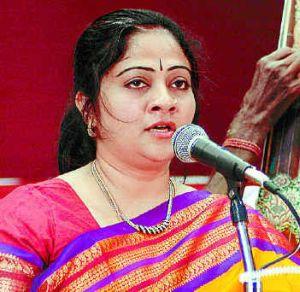Contribute
| A Fabulous Rasikanubhava |
Ranjani Saigal
06/13/2006
Sowmya, whose claim to fame is both in area of Carnatic music performance and her pioneering work in the area of what she calls “Techno-Music†whereby she has used technology to bring Carnatic music to a wider audience, presented a Bhava-laden concert under the auspices of Lalita Kala Lahiri, which is the cultural wing of the Sri Meru Foundation on Sunday, June 5, 2006 at the Nashobha Valley Technical High School in Westford, MA. She was accompanied on the Violin by Sri Ramkumar and on the Mridangam by Neyvelli Gopalan. Sowmya’s technical expertise and her rendition of the Carnatic music pieces with a clear understanding of the meaning and her sensitivity to the emotion of the piece made the concert a treat for the listeners. Sowmya began her concert with the Varnam Sarasuda in the Ragam Saveri. Rama Bhakti in Suddha Bangla followed. Through her emotive portrayal of the Sahitya, Sowmya was able to bring out the essence of the piece. She followed this with Ennalu Urage in Subha Pantuvarali. Sowmya paid her obeisance to Devi through the beautiful Dikhshitar composition Tripura Sundari in Ragam Syama. The piece itself is a fantastic creation by great composer and her excellent Swaraprastaras succeeded in beautifully embellishing this fine piece. In yet another offering to Devi, Sowmya presented the Tamil composition Ennai Nee Maravadhe dedicated to Goddess Meenakshi (referred to as “Angayar Kanniâ€) in Amrithavarshani ragam. She creatively arranged the Kalpana Swarams so that often the note “Ni†coincided with the “Ni†word of the Sahityam in the “Ni Maravadeâ€. A beautiful Alapanai (Raga Elaboration) of the Ragam Nayaki was followed by the presentation of Thyagaraja’s Nee Bhajana Gana Rasikula. Next there was a brisk presentation Thyagaraja’s Narada Muni in Ragam Kamavardini. Ponaiyya Pillai’s Amba Neelambari Ananda Sagari in Neelambari was a unique and off-beat piece. Neelambari often a Ragam used for Talatu (lullaby) is a soothing ragam and is perfect to express the love of the Divine Mother for her children. Sowmya moved into a ragamalika Ragam-Tanam-Pallavi(RTP). She presented a wonderful Todi alapana that brought out the essence of the Ragam. Starting slow she took her time to expound its subtleties before moving to the Tanam. Her strong grasp of Layam was clearly evidenced in her rendition of the Pallavi. Considering that she was performing for Soundarya Lahiri, she appropriately chose a Pallavi in honor of Devi in Khanda Thriputa. This gave her opportunity to present very interesting Swara phrasings while using complex rhythmic structure. In the Kalpana swaram section she also presented Mohanam, Kanada, Vasantha and Shivaranjani. In her skilled presentation, she never let the complexity of the rhythm get in the way of the Bhava of each Ragam. This made the RTP very enjoyable. The accompanists also worked well with her to provide the right support. Gopalan in the typical style of his Guru, Sri Umayalpuram Shivaram succeeded in not just embellishing the rhythmic structure but also made the accompaniment melodic. The Tani at the end of the RTP was brilliant. After the RTP Sowmya was gracious enough to accept requests and rendered many short compositions. Nandanandana nandalahari in Bhimplasi, Manasa Sancharare in Syama, Nagagandhari raganuthe in Nagagandhari in honor of Nagraja, Neyyamuna Kailasa a Padam in ragam Ghanta, Manadhukkugandhadhu in Sindhu Bhairavi were presented. It was nice that as a tribute to her Guru Smt. Mukta the queen of Padam singing she included a Padam in her presentation. To the delight of the Tamils in the audience she presented Rajaji’s famous Kurai Onrum Illai in Ragam Shivaranjani. The Nandanar Charitram song Chidambaram Pohamal in Kunthalavarali and the Kavadisindhu in Kurunji were also delightful. The repertoire also included a rendition of Krishna Nee Begane in Yaman Kalyani. The concert ended with a Tillana in Mandari. Sowmya’s concert attempted to please both the connoisseurs of Carnatic music who look for technical expertise and the unusual and those that are drawn to music because of the words and the feelings of the composition that want to hear familiar pieces. She and the accompanists succeeded admirably and the audience left with a feeling of satisfaction.
You may also access this article through our web-site http://www.lokvani.com/
